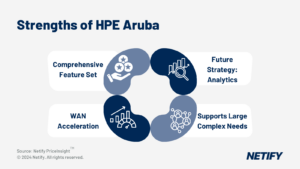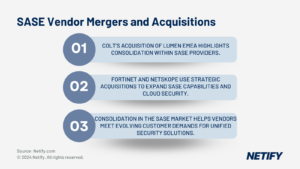| Choosing an SD-WAN vendor requires evaluating performance, security (SASE/SSE), scalability and management features for reliable, secure, and future-proof network solutions. |
Prior to researching SD-WAN vendors and managed service providers, IT teams are required to understand the criteria to use when evaluating and comparing solutions. In 2024, evaluation criteria is firmly centralised around cyber security, specifically SASE (Secure Access Service Edge) and SSE (Secure Service Edge). In many ways, this is perhaps the biggest change over the next few years as IT teams focus on SD-WAN as another component of their security policies and strategy.

SD-WAN Technical Evaluation Criteria
Performance and Application Experience Evaluation
When choosing your prospective SD-WAN vendor, there is a need to understand how your business critical and delay sensitive applications will perform. This is especially true for global multinational businesses which require the best possible metrics across latency, packet loss, jitter, and MOS (mean opinion score) for voice services.
There are SD-WAN vendors and managed providers with global IP backbones, these private networks are designed to route data packets between PoPs via multiple ‘best path’ resilient and diverse circuits. In many ways, SD-WAN provider backbones are analogous to legacy MPLS networks which are traffic engineered to create the most optimal paths for global businesses. The questions IT teams are asking is whether to select an SD-WAN solution with private IP backbone or to opt for a solution which builds a host to host IP VPN with no intermediary network (other than the vanilla Internet).
Proof of concept is the most efficient method of testing SD-WAN performance, enabling your business to conduct pre-deployment tests to pinpoint any operational challenges. The evaluation of network performance is possible at the host to host level, which helps to understand where any potential issues might occur as packets move through different network nodes.
SD-WAN solutions offer varying levels of techniques with some providing NAPM (Network and Application Performance Management) tools, which capture detailed data at a high rate with analysis. Choosing solutions that provide NAPM capability is necessary if your business is running multiple application types.
It is also crucial for a solution to integrate metrics with cloud and infrastructure, such as SaaS, PaaS, IaaS, as well as virtualised, hybrid, and private architectures. Automated traffic analytics and extensive application protocol support are features that ensure quick identification and resolution of network congestion, contributing to overall improved network performance.

Application Performance and Reliability Benefits
Visibility and Control Assessment
SD-WAN visibility and control impact the way in which the network is managed and performs on a real-time basis. The SD-WAN orchestrator is responsible for central management of solutions together with providing detailed analytics and reporting via dashboard that displays historical data about network traffic, application performance, and anomalies.
IT decision makers do not typically research SD-WAN orchestration as such, the focus is more about the solution capability delivers monitoring and service levels. Real-time performance statistics were simply not available without significant investment prior to the advent of SD-WAN. The barrier for entry has now been reduced with real-time operational insights a necessity to understand metrics across transport interface distribution, VoIP quality, and reachability.
Armed with statistics, analytics enable IT management to determine the root causes of network issues. The analysis of stats is often achieved through advanced algorithms and data elements, which deliver detailed insights into network flows by displaying simple visual representations.
SD-WAN is capable of analysing the flow of data to help with issue resolution and adds, moves, and changes. As an example, trends are easily spotted at a granular level, which translates into the SD-WAN solution making real-time changes using AI and in-built logic. The data is also viewable and can be analysed by your IT team to understand trends. These statistics provide the environment to successfully managed applications across cloud services from Azure, AWS or Google Cloud.
The SD-WAN platform should enable businesses to assess their network performance against SLAs with reporting functionalities. Aryaka is particularly strong here, as their interface displays an inventory of your services against SLA performance. Historical data analysis benefits trend recognition and assists with capacity planning to ensure the network remains resilient and agile.
Security and SASE Integration Analysis
Gartner introduced the SASE framework to help quantify the features required to secure any Enterprise business. SASE is the over-arching framework where research into solutions should begin. The decision-making process involves understanding how SD-WAN delivers capability within the SASE framework.
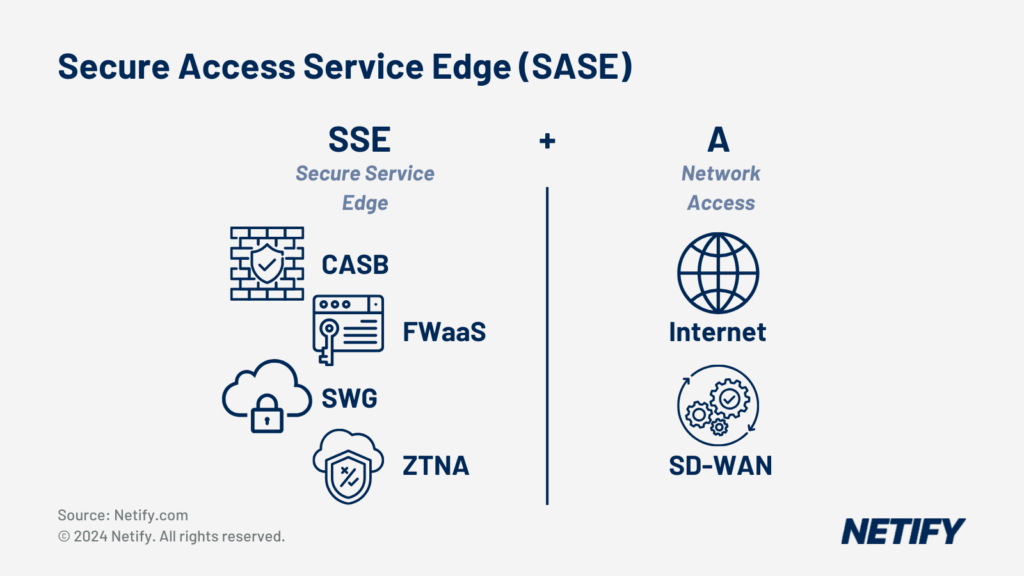
Secure Access Service Edge (SASE) is SSE + SD-WAN (Access).
Although SD-WAN technology requires SASE to fully secure the network, features such as micro segmentation are used to isolate network segments in order to reduce the attack surface. Identity-based policy management grants network access based on user credentials to ensuring that sensitive information is only accessible to authorised personnel. SD-WAN is often integrated into next-generation firewalls (NGFW) with URL filtering to provide real-time monitoring and control of web traffic – Fortinet is a good example.
SASE has changed the WAN market by introducing significant capability and features with cloud-delivered security services. The SASE framework includes Zero Trust Network Access (ZTNA), which implements strict identity verification and context-based access for remote users. The integration of SASE reduces costs and a simplifies security infrastructure by eliminating the need for multiple end-point products.
The implementation of SD-WAN with SASE requires analysis of deployment options, which includes physical appliances, software instances or cloud services. Transitioning and migrating to SASE architectures involves moving from a traditional data centre-focused model to a more distributed approach. This shift means that security policies become more consistent across whatever architecture is implemented regardless of location (remote or branch-office).
When choosing and comparing SD-WAN, vendor solutions should offer strong end-to-end visibility and dynamic recognition to new threats. This selection process must also consider the management and configuration changes associated with SASE – aim for a network architecture that combines performance with a strong security posture.
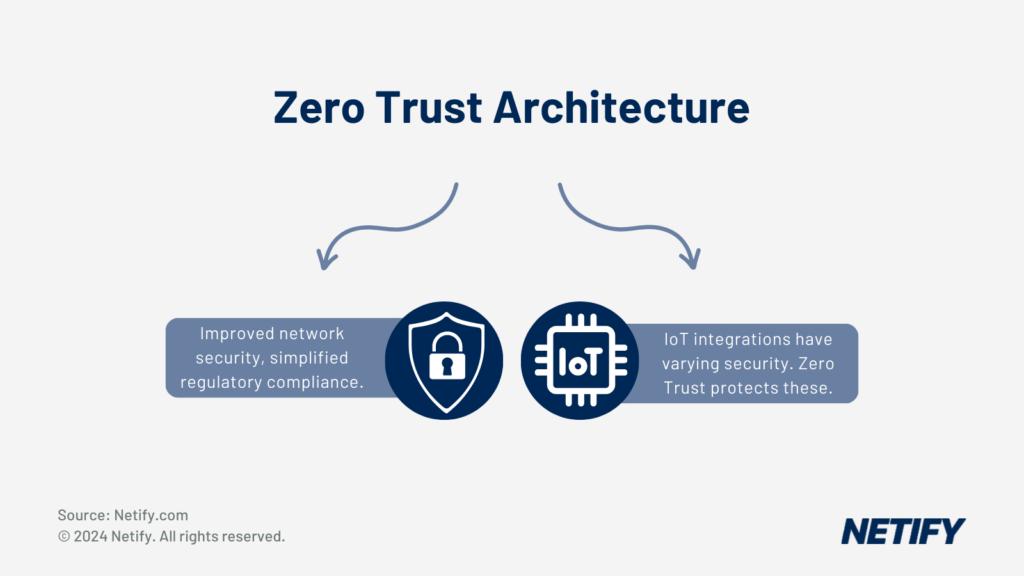
Zero Trust Architecture with SD-WAN
Centralised Management and Simplification Importance
Centralised cloud-based management is at the core of all SD-WAN products regardless of their topology. Centralisation allows administrators to build configurations and policies across multiple locations through a single interface and command line to enhance efficiency and reduce complexity. When choosing from SD-WAN vendors, consider how the solution implements and executes Zero-touch provisioning to understand how you can further simplifiy network deployment by automatically configuring remote devices upon connection.
A central orchestrator manages traffic loads and automates data path distribution to avert potential bottlenecks. The Implementation of policy-based routing allows for the utilisation of various transport methods, i.e. Broadband, leased lines, 4G and 5G connectivity. The management of multiple SD-WAN devices represents a huge challenge as applications require fair traffic distribution to service users.
Good visibility across the network is required for engineering and operations leaders to effectively monitor and manage operations. Centralised management is the enabler to network visibility by automating response mechanisms that expedite the resolution of security incidents. Ultimately, leveraging centralised SD-WAN management results in improved agility, security, and reduction in the cost of network infrastructure that aligns with business growth.
Global Orchestration and Remote User Deployment
It is now essential for all SD-WAN solutions to deliver zero-touch provisioning (ZTP). With ZTP, devices automatically configure themselves when connected to the network, which vastly reduces the time and resources traditionally required to setup a network. As you might expect, not all SD-WAN solutions deliver effective ZTP capability.
Remote user orchestration delivers resources and applies policies consistently to remote users and branch-office sites. The orchestrator allows businesses to maintain control over the network even when connectivity spans multiple countries and regions. SD-WAN is capable of integrating different network services and security protocols, which is needed to maintain optimal performance.
However, managing a global SD-WAN environment presents specific challenges, such as differing regulatory environments and fluctuating Internet service quality. The evaluation of the orchestrators capability to deliver ZTP, combined with effective remote deployment practices is again one of the main decision making factors.
Businesses need to maintain uniform network policies, roll out new locations efficiently, and quickly adapt to changing needs.
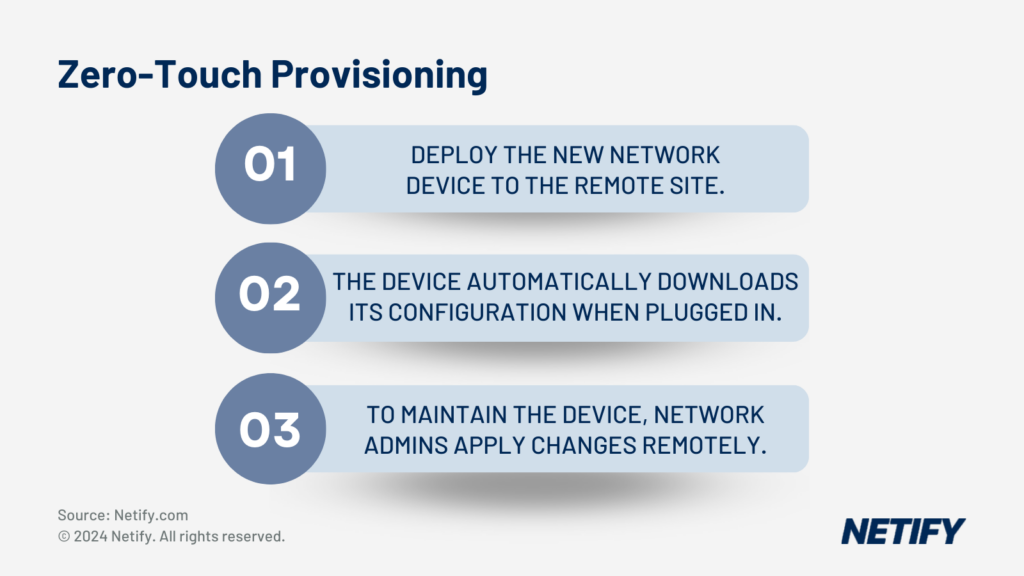
The steps of Zero Touch Provisioning (ZTP)
Transport Independence and Flexibility Evaluation
When considering transport independence, an SD-WAN solution should enable the creation of an overlay network that seamlessly tunnels traffic across diverse transport types. This approach negates the need for multiple physical links, resulting in potential cost savings and enhanced application performance due to reduced latency. The transport-agnostic nature of SD-WAN allows for the easy integration of additional circuits to enable additional bandwidth or resilient connectivity.
SD-WAN uses dynamic path selection and load balancing to enable the distribution of traffic across multiple links. The solution can utilise a combination of MPLS, broadband, and cellular networks, including 4G and 5G. The SD-WAN approach to traffic management provides the ability to direct application traffic using the most efficient route on a real-time or traffic engineered basis.
Remote workers and backup solutions are driving the need for SD-WAN support of cellular technologies. An SD-WAN solution with the capability to incorporate 4G and 5G equips organisations with the infrastructure needed for IoT deployments, mobile workforces, and branch-office connectivity.
Taking into account the shift towards LTE and 5G technologies, it is important for IT decision makers to evaluate the solutions capability to support cellular services.
Managed Services and Support Examination
Providers that offer managed SD-WAN services take on the responsibility of addressing network issues. Managed services encompass a range of support options, from basic troubleshooting to more complex analytics and everything in-between. One of the major selling points of SD-WAN is the ability to opt for co-managed services. IT teams are no longer forced to choose one or the other and can consume and as-a-service approach.
An SD-WAN provider’s experience and the breadth of their service catalogue are factors for companies in the selection process. Services should be aligned with the business’s specific operational needs and objectives. It is equally necessary to have a comprehensive service level agreement (SLA) to ensure responsibilities, performance metrics, and expectations are documented.
Companies must also evaluate potential providers on their capability to deliver continuous updates, address threats effectively, and troubleshoot issues rapidly.
Deployment Models and Flexibility Assessment
When choosing SD-WAN deployment options, organisations must consider the architecture that caters specifically to operational needs and scalability requirements. An on-premises deployment enables full control over both the SD-WAN edge devices and the WAN operations, but there is typically an initial capital outlay. Cloud-based SD-WAN services offer an open model with minimal upfront costs and simplified WAN operations management – these consumption-based services are becoming increasingly client based.
A hybrid SD-WAN approach merges on-premises with cloud environments to provide a blend of control. Organisations benefit from placing sensitive data on-premises while exploiting the cloud’s efficiency in resource scaling and expedited services deployment with ZTP. The decision on a deployment model must factor in network architecture, compliance stipulations, and performance requisites.
Flexibility is one of the major benefits of SD-WAN. The addition of new network sites, bandwidth scaling, and policy modifications should be executable without significant operational disruption. SD-WAN’s agility is essential in supporting an enterprise’s growth and its adaptiveness to technological advancements.
Organisations must evaluate the interplay between control, expenditure, and adaptability to ascertain that the implementation not only meets current needs but is also viable for future objectives. Proper evaluation ensures that the chosen SD-WAN solution is commensurate with the long-term strategy of the business.
Extensibility and Future-Proofing Consideration
Enterprises must ensure that the chosen SD-WAN solution supports scalability to meet future demands via integration capabilities with current and prospective technologies.
SD-WAN solutions which optimally manage and optimise connections across remote locations to multi-cloud networks is needed for almost all organisations. The convergence of networking and security features can often lead to cost reductions and simplification of the infrastructure. The SD-WAN market is rapidly growing, with expectations to expand significantly by 2030 driven by cyber security and access to the cloud.
Emerging trends include AI-driven applications, secure remote access, integration with 5G, and managed services. In the near term, organisations must select SD-WAN solutions with the capability to integrate these advancements while being equipped for scalability and sustained performance.
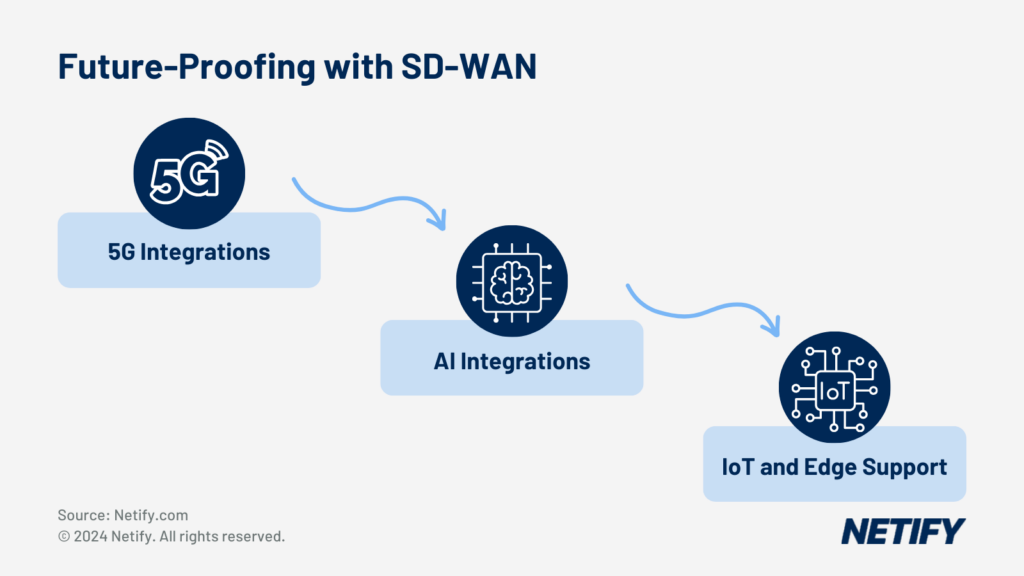
Future Proofing With SD-WAN
